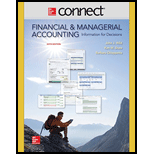
Concept explainers
The assets, liabilities and equity relation, are known as the accounting equation. Assets are the resources of company and that increase as business expand whereas liabilities are the burden on company that has to pay in future; Equity means the owner claim on assets. An accounting equation represent the assets of the company are equal to the liabilities and equity of the company.
In can be represented as follow,
Assets:
Assets are the resources that a company needs to run the business. An asset is economic resources of the company.
Liabilities:
Liabilities are generally the amount owned by the company from lenders, suppliers, or bank. Liabilities are the burden on the company that they have to pay to others.
Equity:
The company needs finance to run the business. Equity is one of the method through which the company raise the capital.
To explain: The example of each given effect of accounting equation.
Want to see the full answer?
Check out a sample textbook solution
Chapter 1 Solutions
Connect 2 Semester Access Card for Financial and Managerial Accounting
- Can you explain this general accounting question using accurate calculation methods?arrow_forwardNeed helparrow_forwardCumberland Industries reported net sales of $5.75 million and beginning total assets of $2.20 million and ending total assets of $2.90 million. What is the average total asset amount? a. $2.75 million b. $3.10 million c. $2.55 million d. $0.45 million e. $1.38 millionarrow_forward
- Please provide the correct answer to this general accounting problem using valid calculations.arrow_forwardI need help with this general accounting question using standard accounting techniques.arrow_forwardI need help finding the accurate solution to this general accounting problem with valid methods.arrow_forward
- Can you solve this general accounting problem using appropriate accounting principles?arrow_forwardPlease provide the correct answer to this general accounting problem using valid calculations.arrow_forwardI am searching for the correct answer to this financial accounting problem with proper accounting rules.arrow_forward

 AccountingAccountingISBN:9781337272094Author:WARREN, Carl S., Reeve, James M., Duchac, Jonathan E.Publisher:Cengage Learning,
AccountingAccountingISBN:9781337272094Author:WARREN, Carl S., Reeve, James M., Duchac, Jonathan E.Publisher:Cengage Learning, Accounting Information SystemsAccountingISBN:9781337619202Author:Hall, James A.Publisher:Cengage Learning,
Accounting Information SystemsAccountingISBN:9781337619202Author:Hall, James A.Publisher:Cengage Learning, Horngren's Cost Accounting: A Managerial Emphasis...AccountingISBN:9780134475585Author:Srikant M. Datar, Madhav V. RajanPublisher:PEARSON
Horngren's Cost Accounting: A Managerial Emphasis...AccountingISBN:9780134475585Author:Srikant M. Datar, Madhav V. RajanPublisher:PEARSON Intermediate AccountingAccountingISBN:9781259722660Author:J. David Spiceland, Mark W. Nelson, Wayne M ThomasPublisher:McGraw-Hill Education
Intermediate AccountingAccountingISBN:9781259722660Author:J. David Spiceland, Mark W. Nelson, Wayne M ThomasPublisher:McGraw-Hill Education Financial and Managerial AccountingAccountingISBN:9781259726705Author:John J Wild, Ken W. Shaw, Barbara Chiappetta Fundamental Accounting PrinciplesPublisher:McGraw-Hill Education
Financial and Managerial AccountingAccountingISBN:9781259726705Author:John J Wild, Ken W. Shaw, Barbara Chiappetta Fundamental Accounting PrinciplesPublisher:McGraw-Hill Education





